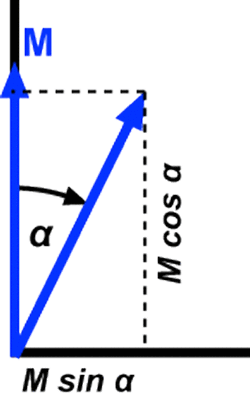The term partial flip angle refers to the use of RF-pulses that tip the longitudinal magnetization some fraction of 90° (e.g., 10°, 45°). Partial flip angle pulses are used widely in association with GRE techniques to minimize signal loss from saturation effects, as well as to provide a means for obtaining interesting new tissue contrasts. They are also used in some advanced spin echo applications as well as many MRA sequences.
|
The figure (right) demonstrates how a partial flip angle pulse creates an appreciable transverse magnetization while disturbing the longitudinal magnetization only slightly. From trigonometric identities we see that when a magnetization vector M initially aligned with the z-axis is flipped by angle α, the transverse and longitudinal components of magnetization after the flip will be [M sin α] and [M cos α], respectively.
For example, a 15°-RF pulse acting on M creates an appreciable transverse component of size [M sin 15°] = 0.26 M, while reducing the longitudinal magnetization only 3% to [M cos 15°] = 0.97 M. |
The fact that the longitudinal magnetization has been largely preserved means that little saturation has occurred, and the next RF-pulse will still have a large reservoir of magnetization from which to generate a signal. This advantage is particularly important when TR is short (i.e., < 100 msec). For short TR sequences a significantly stronger MR signal may be obtained by using partial flip angle (rather than 90°) pulses.
Advanced Discussion (show/hide)»
No supplementary material yet. Check back soon.
References
Haase A, Frahm J, Matthaei KD. FLASH imaging: rapid NMR imaging using low flip angle pulses. J Magn Reson 1986: 67: 258-266.
Mills TC, Ortendahl DA, Hylton NM, et al. Partial flip angle MR imaging. Radiology 1987; 162:531-9.
Haase A, Frahm J, Matthaei KD. FLASH imaging: rapid NMR imaging using low flip angle pulses. J Magn Reson 1986: 67: 258-266.
Mills TC, Ortendahl DA, Hylton NM, et al. Partial flip angle MR imaging. Radiology 1987; 162:531-9.
Related Questions
How does a gradient echo differ from a spin echo?
Wait a minute! If a partial flip angle pulse tips less magnetization into the transverse plane than a 90° pulse does, how can the signal be higher?
How does a gradient echo differ from a spin echo?
Wait a minute! If a partial flip angle pulse tips less magnetization into the transverse plane than a 90° pulse does, how can the signal be higher?

